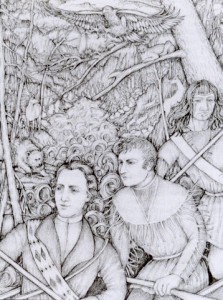|
J. William T. "Bill" Youngs, American Realities, Volume One:
Historical Episodes from First Settlements to the Civil War, Chapter Eight |
Lewis and Clark, courtesy of the Wikipedia Commons
|
8. Republican Nationalism
|
Summary |
|
The Lewis and Clark expedition is a window on both the American character and the natural environment in the early Republic. By following Meriwether Lewis and William Clark on their westward journey across prairies and mountains to the Pacific, we see the grandeur of the early American wilderness. The expedition can also be seen as an indication of the apparently limitless horizons lying before the American people during their first century of independence.
|
Author Reads From the Text
In 1803, the year of the Louisiana Purchase, the United States was a strong, confident nation with a population of 6 million. Americans were building canals, bridges, factories, and highways and experimenting with steamboats and gaslamps. Along the Atlantic seaboard the wilderness had long since vanished, and the land was familiar, lived upon, subdued.
But there was another America, totally unknown to the people of the East. When Thomas Jefferson was elected president in 1800, tens of thousands of Native Americans living within the boundaries of the future United States had never seen a white man. In reality, America was not one country but many. Its nations included Mandans, Sioux, Shoshones, and Nez Percé, as well as the polyglot population of Europeans and African. Few easterners had traveled among the western Indians or seen the Rockies. The United States was bordered by a mystery.
The existence of this unknown land fascinated and challenged President Thomas Jefferson. Although he was best known as a statesman, Jefferson was a deeply contemplative man and an accomplished astronomer, archaeologist, geologist, and naturalist. As a young man, he wrote Notes on Virginia, a natural history of his native region. While in Paris in 1786 he encouraged the American adventurer, John Ledyard, to walk across Siberia and western America to the headwaters of the Missouri. Ledyard, accompanied by two dogs, actually covered three thousand miles across Russia before authorities, suspecting that he was a spy, shipped him back to Poland. In 1792, as secretary of state, Jefferson supported another abortive expedition to the West. As president, Jefferson was determined to try again.
But there was another America, totally unknown to the people of the East. When Thomas Jefferson was elected president in 1800, tens of thousands of Native Americans living within the boundaries of the future United States had never seen a white man. In reality, America was not one country but many. Its nations included Mandans, Sioux, Shoshones, and Nez Percé, as well as the polyglot population of Europeans and African. Few easterners had traveled among the western Indians or seen the Rockies. The United States was bordered by a mystery.
The existence of this unknown land fascinated and challenged President Thomas Jefferson. Although he was best known as a statesman, Jefferson was a deeply contemplative man and an accomplished astronomer, archaeologist, geologist, and naturalist. As a young man, he wrote Notes on Virginia, a natural history of his native region. While in Paris in 1786 he encouraged the American adventurer, John Ledyard, to walk across Siberia and western America to the headwaters of the Missouri. Ledyard, accompanied by two dogs, actually covered three thousand miles across Russia before authorities, suspecting that he was a spy, shipped him back to Poland. In 1792, as secretary of state, Jefferson supported another abortive expedition to the West. As president, Jefferson was determined to try again.
Lewis and Clark's Voyage of Discovery
View American Realities - Lewis and Clark's Voyage of Discovery in a larger map

